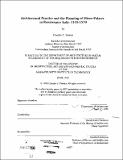| dc.contributor.advisor | David Hodes Friedman. | en_US |
| dc.contributor.author | Pereira, Claudio C. (Caludio Calovi), 1961- | en_US |
| dc.contributor.other | Massachusetts Institute of Technology. Dept. of Architecture. | en_US |
| dc.coverage.spatial | e-it--- | en_US |
| dc.date.accessioned | 2012-02-29T17:24:52Z | |
| dc.date.available | 2012-02-29T17:24:52Z | |
| dc.date.copyright | 1998 | en_US |
| dc.date.issued | 1998 | en_US |
| dc.identifier.uri | http://hdl.handle.net/1721.1/69404 | |
| dc.description | Thesis (Ph. D.)--Massachusetts Institute of Technology, Dept. of Architecture and Planning, 1998. | en_US |
| dc.description | Includes bibliographical references (v. 1, leaves 157-164). | en_US |
| dc.description.abstract | This dissertation proposes to study how the commission and design of minor palaces contribute to the understanding of architectural practice in early 16th century Italy. The particular nature of the small urban palace as a reduced and less expensive version of larger palaces and its recurrent nature in the practice of architects malke this type of building very important in illustrating the changes in the profeSSion at that time. Minor palace commissions also show architects dealing with a growing private market for the exercise of the profession: in Rome, the architect's clients belong to a lesser nobility composed of merchants and professional men (doctors, lawyers, notaries, artists, diplomats, bureaucrats) mostly connected to the Papal civil service. Moreover, the planning of these buildings manifest the increasing specialization of the profession at that time, when expertise in Ancient Roman architecture and the mastering of new instruments of representation (orthogonal projection, perspective, sketches) were added to the usual technical and artistic skills required of an architect. The dissertation focus on how architects define a planning procedure to cope with the new set of circumstances related to the commission of a minor palace (budget, site, program, recurrence). The design of a palace comprised different functions arranged in horizontal sequence with a few vertical connections; therefore, drawings of plans were the central instrument of their design. The dissertation is primarily based on the study of original plans that illustrate the working methods of 16th century Italian architects. Three of them were chosen (Antonio da Sangallo the Younger, Baldassare Peruzzi and Andrea Palladio) based on their activity as ~esigners of minor palaces and the existence of a substantial amount of plans for this kind of building by them. A second part of this work presents a general view of the working procedures employed by these three architects in commissions of minor palaces. Through the study of their drawings and planning procedures, this dissertation intends to illustrate the establishment of the modern sense of architectural practice in 16th century Italy as shown through the design of minor palaces. | en_US |
| dc.description.statementofresponsibility | by Caludio C. Pereira. | en_US |
| dc.format.extent | 2 v. (284 leaves) | en_US |
| dc.language.iso | eng | en_US |
| dc.publisher | Massachusetts Institute of Technology | en_US |
| dc.rights | M.I.T. theses are protected by
copyright. They may be viewed from this source for any purpose, but
reproduction or distribution in any format is prohibited without written
permission. See provided URL for inquiries about permission. | en_US |
| dc.rights.uri | http://dspace.mit.edu/handle/1721.1/7582 | en_US |
| dc.subject | Architecture. | en_US |
| dc.title | Architectural practice and the planning of minor palaces in Renaissance Italy, 1510-1570 | en_US |
| dc.type | Thesis | en_US |
| dc.description.degree | Ph.D. | en_US |
| dc.contributor.department | Massachusetts Institute of Technology. Department of Architecture | |
| dc.contributor.department | Massachusetts Institute of Technology. Department of Urban Studies and Planning | |
| dc.identifier.oclc | 41430177 | en_US |
